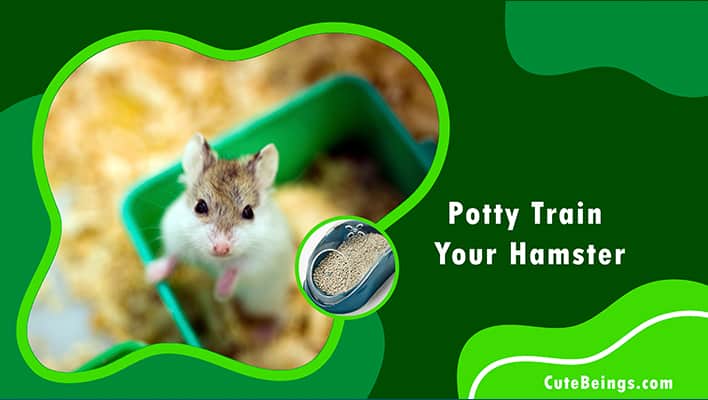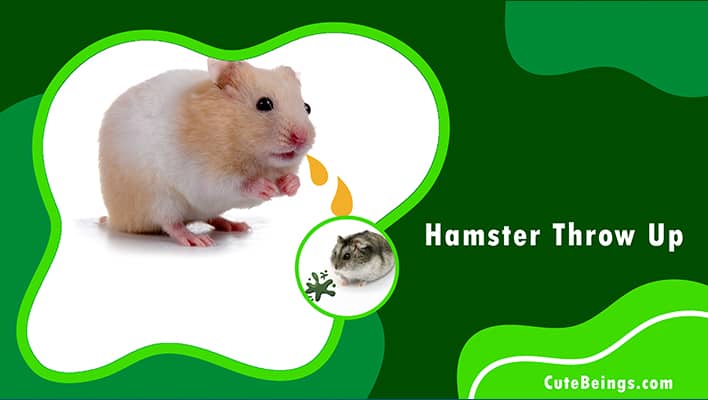Have you ever wondered whether you can potty train your beloved hamsters? The answer to that is, of course, yes, you can. If you are someone who wishes to have a clean cage that doesn’t release any foul smells, potty training would be the one to try out. Hamsters are intelligent animals that pick up on things quickly. Considering that, you can easily potty train the hamsters as well. Hamsters are clean animals who tend to stay clean as much as they can.
As a result, they would naturally prefer to go potty in the same location on a regular basis. This trait enables hamsters to potty train in a short period of time. Once the hamsters get used to pottying, it will be easy for you to maintain the hygiene of their cage. For example, you don’t need to change the bedding there very often. So, in this article, we have covered everything you need to know in this regard.
Table of Contents
Do hamsters need a litter box?
Ideally, yes, hamsters need a litter box so that the hamster’s owners do not need to change the hamster’s bedding constantly. So when you add a potty, it would help the hamsters stay happy and stay away from unwanted foul smells as well.
Are litter boxes good for hamsters?
Litter boxes are undoubtedly good for the hamsters. This means it will be less messy and stay cleaner in the cages. Furthermore, you don’t need to spend plenty of time cleaning up the mess there too. This means both the hamsters and their owners are happy. On top of that, you have so many litter box options to choose from, too. So finding an appropriate litter box would not be that hard.
What is the best litter for hamsters?
If you are sort of looking for a cheap and convenient option, it would be best to use sand. Hamsters will love this, as they just enjoy urinating and digging in them a lot. Anyone can afford to buy them as well. It is very unlikely that they will tend to eat those. Instead, they would love the texture of the sand. Furthermore, hamsters enjoy rolling in the sand. Keep in mind that sand will retain the smell of urine, and due to that, you will have to change it regularly.
Second, consider having critter litter do this task as well. You can easily find them at pet stores. To briefly explain what critter litter is, it is more like a commercial product. It is made out of nontoxic material that is absorbent. It helps the litter surface stay dry and keeps the smell in the litter box contained as well. Not only that, but it would be easy for you to scoop them out of the litter box too.
The only disadvantage would be that it would be somewhat expensive. I don’t suggest choosing this option if you have multiple hamsters in one cage. Furthermore, if the hamsters eat critter litter, it will have a negative impact on their health. So, if you have a hamster who eats everything in sight, critter litter is not the best choice.
In addition to the aforesaid options, you can also consider using paper litter for this purpose. You can easily find these at local pet stores. Moreover, you can also consider making paper litter on your own by tearing up newspaper sheets into small strips or even into pellets. Keep in mind that paper litter would absorb the urine quite well. Furthermore, they would not emit any foul odor. It goes without saying that cleaning them out would be a breeze.
The litter box for the hamster
You can choose a plastic litter box for hamsters. Plastic litter boxes are easily available at local pet stores. Further, you may purchase them online as well. You could see that most of the commercial litter boxes come in triangular or rectangle shapes so that they can fit in the hamsters’ cages quite well. You can find plastic litter boxes that come with lids as well.
Apart from plastic litter boxes, you may use a glass dish or a glass bowl too. If you are on a tight budget and want to try making a litter box on your own, you may try out this option. Glass litter boxes are a fine option, as hamsters cannot chew on them. Not only that, but you can rinse them pretty easily too. When you choose this, make sure that you select a litter box that is slightly bigger than the hamster. Besides, it has to have high walls, too.
Furthermore, you can also consider getting plastic Tupperware. However, the Tupperware you select should contain a lid as well. In addition to that, you can also try using a cardboard box as the litter box. It is cheap. Furthermore, you can make it much faster. Once you finish using it, you can even replace it quite easily with another new box. It is noteworthy that cardboard can even soak up urine in the sand as well. That way, it would not make the litter box wet as well. However, a cardboard litter box would only be a temporary option. I don’t recommend using this as a permanent option.
Can hamsters potty train?
Yes, certainly you can potty train the hamsters, and you may use a litter box to do this task. Usually, hamsters urinate in one particular spot, so training them would not be a difficult task.
How to potty train a hamster
First, you need to wait until the hamsters choose the potty corners. I don’t suggest you choose a spot. Instead, you need to allow the hamsters to choose a spot for the potty to be kept. If the hamsters go to one particular space in the cage, you can choose that spot for the potty. Keep in mind that you chose that area for placing the potty. If you place the potty in a random spot, chances are that the hamsters will ignore it. Instead, they would go to the bathroom, where they are used to going.
Thereafter, you need to pour the litter into the litter box. Ensure that you apply litter in a way that will cover the litter box bottom. Next, you can add a little bit of soiled bedding and some drooping as well. That mix would indicate the hamsters use that litter box for bathroom purposes.
After that, you can place the hamster in the litter box. However, when you place the hamsters in the litter box, ensure that you do it when they are awake and actively moving in the cage. However, don’t force them to use the potty at the very moment you put them there. Allow it some time so that they will get used to the new conditions in the box.
How do you maintain the potty training?
First, you need to ensure that they have a separate place to sleep and eat as well. That way, you can ensure that they don’t use this spot for eating or sleeping. If the hamsters don’t opt to sleep in their regular place, chances are that they may end up sleeping in the pot that you need to avoid. As such, you need to ensure that there is enough space for them to sleep as well as to eat.
Further, if you have an excessively large hamster cage, I suggest you keep two potties in both corners of the cage so that they will continue using both potties. Further, there could be some hamsters who would use the potty to urinate only. They will also pass the stool outside the toilet. However, what is good about this is that you can easily pick up their feces in their cage, unlike the urine. After that, flush them down the toilet.
What are the common problems you may come across when potty training?
You may come across several problems using the potty for the hamsters. For example, if your hamsters are sleeping in the litter box, it is likely that they do not prefer their usual sleeping spot. Further, if there is no designated place for the hamsters to sleep, try allocating a proper place for them to sleep. Further, if the hamsters are in a small cage, they will tend to use the potty as a food hiding spot. In addition to that, hamsters may tend to eat the litter as well. So if the hamsters end up eating hazardous ingredients contained in the litter, it would result in unnecessary trouble for the hamsters.
What to put in the hamster litter box
Hamster litter sand
When it comes to hamster litter sand, keep in mind that not all sand types are appropriate for this purpose. What I suggest you choose to do for this task is use chinchilla sand. However, one might find this somewhat costly. That said, every good thing comes with a price, and this would be one of the safest sand types to use for the hamsters.
When you use sand, and chinchilla sand in particular, it would be easy for them to burrow underneath them, cleaning them as well. In other words, it would be comfortable for them. However, if you tend to use another sand type, it would be best to sterilize them and then use them. Hamsters may sometimes tend to eat sand. As a result, you must ensure that the litter box is cleaned on a daily basis.
How often should I clean my hamster’s litter box?
You should ideally clean the hamster’s litter box once a day. It should be a daily routine for you, as that way you can maintain the hygiene of the litter box. Ensure that you replace the litter with fresh litter regularly. Ideally, you need to replace the litter and rinse and wash the litter box as well. Once you do this, it will stay fresh. When you clean it, you need to see exactly where the hamster peed. Clean that place properly so that it will remove all the remaining traces of the hamster’s urine. Some people even try using disinfectants so that they will remove the foul odor that is released from the litter box.
DIY hamster potty
Find a container that fits perfectly into the cage’s corner for your hamster.
Use a triangle toilet or a simple square or rectangle that is large enough for your hamster to comfortably use the restroom.
Provide absorbent substrates in the toilet.
The best option is sand; however, pellets made of wood or paper are also suitable. You can utilize a single absorbent substrate, such as sand, or a combination of substrates, such as sand plus pellets.
Sand works well as a toilet substrate because it makes liquids clump together in isolated areas. Then, while doing a spot clean, these are simply picked up.
The ability to manage odor is paper and wood pellets’ principal benefit. These can be skipped if you plan to spot-clean every day.
Frequently Asked Questions (FAQ)
Can I use cat litter for my hamster?
I don’t recommend using cat litter as the bedding. However, you may consider using them as a base layer. You may use wood- and paper-based cat litter only as the base layer.
Final words
So, to conclude, if you wish to keep the hamster’s cage tiny, clean, and neat while having no foul odor at all, the best method you could use to do that is by using the potty. Cleaning them would be quite easy as well. So try training your beloved hamsters to go potty and worry less about the hassle of cleaning their cage. Keep in mind that once the hamsters are potty trained, it will be quite efficient to clean their cage. So, I hope now you are all set to try this out with your beloved hamsters!

Hello I’m Jason Daniel, it’s nice to meet you. As a professional veterinarian, I have a wealth of knowledge and experience to share with you. Writing articles about small pets is a great way to share my expertise and help you take better care of your pets.




